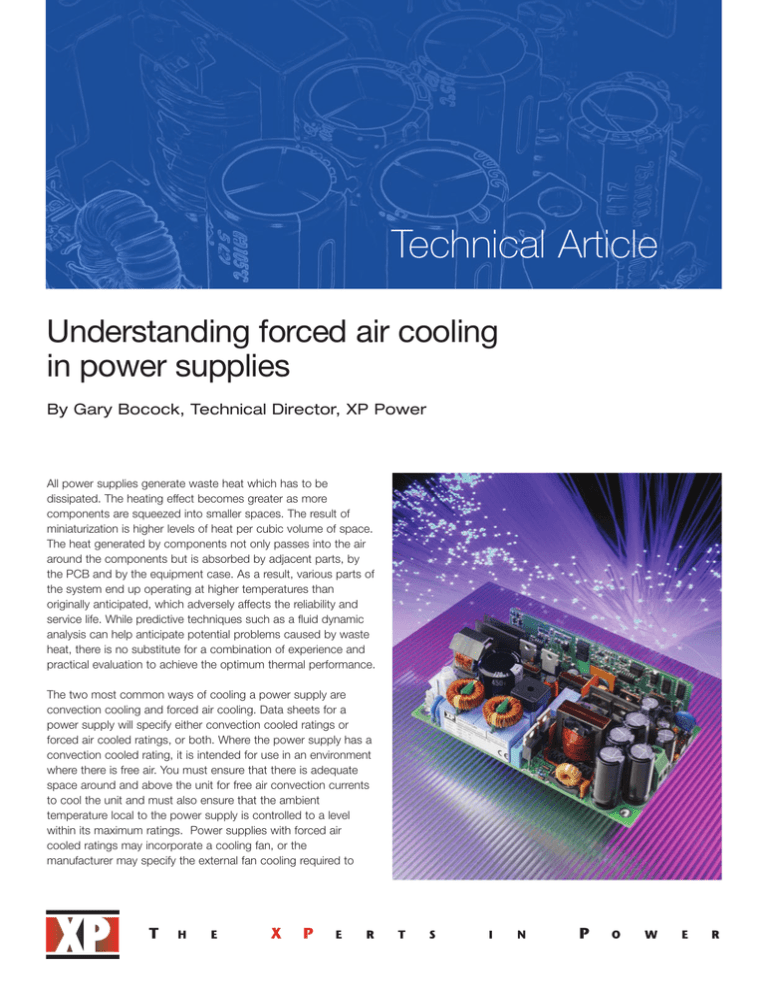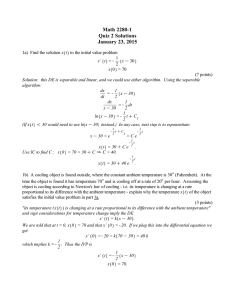Understanding forced air cooling in power supplies
advertisement

Technical Article Understanding forced air cooling in power supplies By Gary Bocock, Technical Director, XP Power All power supplies generate waste heat which has to be dissipated. The heating effect becomes greater as more components are squeezed into smaller spaces. The result of miniaturization is higher levels of heat per cubic volume of space. The heat generated by components not only passes into the air around the components but is absorbed by adjacent parts, by the PCB and by the equipment case. As a result, various parts of the system end up operating at higher temperatures than originally anticipated, which adversely affects the reliability and service life. While predictive techniques such as a fluid dynamic analysis can help anticipate potential problems caused by waste heat, there is no substitute for a combination of experience and practical evaluation to achieve the optimum thermal performance. The two most common ways of cooling a power supply are convection cooling and forced air cooling. Data sheets for a power supply will specify either convection cooled ratings or forced air cooled ratings, or both. Where the power supply has a convection cooled rating, it is intended for use in an environment where there is free air. You must ensure that there is adequate space around and above the unit for free air convection currents to cool the unit and must also ensure that the ambient temperature local to the power supply is controlled to a level within its maximum ratings. Power supplies with forced air cooled ratings may incorporate a cooling fan, or the manufacturer may specify the external fan cooling required to xppower.com operate the unit at maximum load and ambient temperature. You should study power supply data sheets carefully early on in the design to decide if external cooling is needed. air speed, which is the important factor. The objective is to maintain the components used within the power supply at a safe operating temperature and to ensure adequate service life. The main difference between convection and force-cooled products is in the power density delivered for a given efficiency. Convection cooled products typically offer a lower power density than force cooled products, meaning that they occupy a larger volume. For example, a power supply on a 3” x 5” industry standard footprint may have a convection rating of 100W while the force cooled version may have a rating as high as 200W. The use of fans is growing, as more applications put increasing emphasis on achieving the best possible power density. When the required airflow is specified in CFM it assumes that the power supply is installed in an area that is reasonably similar to its own cross sectional area. This is rarely the case, as the power supply is typically used as a sub-assembly within a complete equipment enclosure. It will also assume that the air is directed at the power supply, which may also not be the case, so converting to Linear Feet per Minute (LFM) or metres per second (m/s) provides a more valid criterion – linear air speed measurements specify where the air is flowing and directly relate to heat transfer. Forced cooling Force-cooled products with integral cooling fans are relatively easy to implement in a design – it is a simple matter of ensuring that the maximum specified ambient temperature is not exceeded for a given load rating, and that the intake and exhaust areas are not obstructed. Where you need external cooling, it has to be adequate, as increased temperature can have knock-on effects on the reliability and lifetime of the power supply and the system. The amount of cooling needed is application-specific and dependent on the ambient temperature, applied load and physical location with respect to the cooling fan and other system assemblies. Where forced air cooling is needed, the degree of cooling is of importance in determining the environmental performance of a power supply and its operating life. The cooling fan itself is almost always the component with the shortest lifetime because it is a mechanical device with a wear-out mechanism. If a power supply needs 30CFM cooling, the fan will be running fast, wearing out relatively quickly, taking more power and making more audible noise, compared to a power supply that needs 12CFM cooling. Well-designed 100/200W power supplies with best-in-class power density should not need more than 12CFM cooling to achieve their maximum ratings, and many need only 5CFM. However, there are still plenty of power supplies on the market that require 30CFM or more to deliver similar ratings, so it pays to examine data sheets carefully in this respect. Typically, power supplies that require you to provide forced air cooling will specify a minimum required airflow. This is usually for operation at 100% of the power rating at the maximum ambient temperature allowed. The required airflow is often specified in Cubic Feet per Minute (CFM), which is also the common rating method for cooling fans. The effectiveness of cooling fans installed in enclosures must be given consideration, and remember that the CFM rating deals in volume of air rather than Example For XP Power’s EMA212 power supply, the manufacturer’s data sheets state that it requires forced air of 12 CFM in the direction indicated by the arrow on Figure 1. The cross sectional area is: 3” x 1.34” = 4 inches2 or 0.028 feet2 Figure 1: The EMA212, 212W power supply requires forced air cooling of 12CFM in the direction indicated by the arrow. 2 xppower.com Therefore the air velocity required is: While these figures will ensure safe operation, they do not give any indication of the service life that can be expected. 12/0.028 = 429 LFM or 2.17 m/s This air speed can be measured locally to the power supply to ensure that sufficient forced air cooling is being applied. Testing Given the huge potential for variation between one application and another, the only real test is measurement of the temperature of the critical components within the power supply assembly when installed within the end application under the worst case external ambient conditions. Another option would be to model the application exactly using a suitable software simulation. The criteria for safe operation will be specified for the power supply in question or can be obtained from the manufacturer. For the example above, the specific component temperatures for safe operation for the EMA212 are given in Table 1; these are typical for a power supply of this type. Table 1: Maximum operating temperatures for components labelled on Figure 1 in the EMA212 power supply. The lifetime of a power supply is largely determined by the temperature of the electrolytic capacitors, which have a wear out mechanism. As a general rule, capacitor lifetime can be doubled for every 10°C drop in operating temperature. The graph in figure 2 indicates the expected service life of the EMA212 power supply based on measurement of two key electrolytic capacitors. Following the manufacturer’s guidelines for safe and adequate cooling should always result in a safely operating power supply that meets or exceeds its life expectancy. In summary, if a power supply requires convection cooling, then it’s usually just a matter of making sure that there is sufficient space around the power supply and that the ambient temperature isn’t exceeded. Power supplies that include a fan require careful installation to ensure their intake and exhausts are not blocked. Applying your own external cooling is more complex, but air flow around the unit can be measured to make sure adequate air flow is forthcoming. As a final test, the temperature of critical components on the power supply can be measured to ensure they are within safe limits. Some manufacturers, including XP, offer thermal analysis services to determine these parameters and, in practice, it is only this kind of measurement and analysis, carried out in real-world operating conditions, which delivers results that can be relied upon with a high degree of confidence. Decreasing the operating temperature of these components below the maximum, especially for electrolytic capacitors, will also markedly improve the service life of a PSU. Figure 2: The increase in product service life caused by keeping the electrolytic capacitors at lower temperatures 3 www.xppower.com North American HQ Asian HQ XP Power 990 Benecia Avenue, Sunnyvale, CA 94085 Phone : +1 (408) 732-7777 Fax : +1 (408) 732-2002 Email : nasales@xppower.com XP Power 401 Commonwealth Drive, Haw Par Technocentre, Singapore 149598 Phone : +65 6411 6900 Fax : +65 6741 8730 Email : apsales@xppower.com Web : www.xppowerchina.com / www.xppower.com North American Sales Offices Toll Free.........................+1 (800) 253-0490 Central Region...............+1 (972) 578-1530 Eastern Region ............+1 (973) 658-8001 Western Region.............+1 (408) 732-7777 Asian Sales Offices Shanghai ....................... +86 21 51388389 Singapore.......................... +65 6411 6902 European HQ German HQ Distributors XP Power Horseshoe Park, Pangbourne, Berkshire, RG8 7JW, UK Phone : +44 (0)118 984 5515 Fax : +44 (0)118 984 3423 Email : eusales@xppower.com XP Power Auf der Höhe 2, D-28357 Bremen, Germany Phone : +49 (0)421 63 93 3 0 Fax : +49 (0)421 63 93 3 10 Email : desales@xppower.com Australia ..........................+61 2 9809 5022 Balkans ...........................+386 1 583 7930 Czech Rep. ...................+420 235 366 129 Czech Rep. ...................+420 539 050 630 Estonia ................................+372 6228866 Greece ..........................+30 210 240 1961 Israel ................................+972 9 7498777 Japan ..............................+81 48 864 7733 Korea ..............................+82 31 422 8882 Latvia ................................+371 67501005 Lithuania...........................+370 5 2652683 Poland..............................+48 22 8627500 Portugal..........................+34 93 263 33 54 Russia ...........................+7 (495)234 0636 Russia ...........................+7 (812)325 5115 South Africa.....................+27 11 453 1910 Spain..............................+34 93 263 33 54 Taiwan ..............................+886 3 3559642 Turkey ...........................+90 212 465 7199 European Sales Offices Austria ........................+41 (0)56 448 90 80 Belgium .....................+33 (0)1 45 12 31 15 Denmark ..........................+45 43 42 38 33 Finland........................+46 (0)8 555 367 01 France ......................+33 (0)1 45 12 31 15 Germany....................+49 (0)421 63 93 3 0 Italy ................................+39 039 2876027 Netherlands ...............+49 (0)421 63 93 3 0 Norway.............................+47 63 94 60 18 Sweden ..................... +46 (0)8 555 367 00 Switzerland ................ +41 (0)56 448 90 80 United Kingdom.........+44 (0)118 984 5515 Amtex Elbacomp Vums Powerprag Koala Elektronik Elgerta ADEM Electronics Appletec Bellnix Hanpower Caro Elgerta Gamma Venco Prosoft Gamma Vepac Venco Fullerton Power EMPA Global Catalog Distributors Americas ........................................Newark Europe & Asia...................................Farnell China ............................Premier Electronics newark.com farnell.com premierelectronics.com.cn August 09



